Cultural resources and climate change: bridging the relevancy gap
19 December 2016 – Rick Kendall
Editor’s note: This is the second of a series of blog posts commissioned by The Public Historian on the topic of history and the interpretation of climate change in the national parks, extending the conversation on history in the national parks during this centennial year begun in its November 2016 issue. Read other posts in the series.
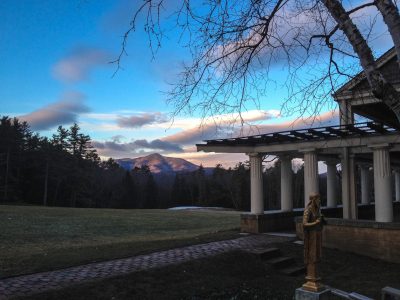
Sunrise over Mount Ascutney, from the Little Studio, Saint-Gaudens National Historic Site. Photo credit: National Park Service.
When it comes to climate change, some impacts are more easily recognized than others. Rising sea levels, melting glaciers, and changing ecosystems are just some of the more visible impacts of changing climate. National parks along the coast or that include glaciated peaks or are squarely in the crosshairs for evolving ecosystems have been the early focus of the National Park Service’s efforts at climate change response. These high-profile issues are just the tip of the iceberg; all parks, even small historic sites, will have to contend with changes to their local climate. And many of the changes are the same changes that the visiting public can expect at their homes and gardens.
At Saint-Gaudens National Historic Site in New Hampshire, we have been monitoring the effects of climate change for many years now. One of the biggest potential impacts at the park could be to our cultural landscape, and we are already noting changes in local phenology. Over the last few years, the bloom schedule appears to have advanced dramatically. In 2012, the park’s bloom schedule was more than a month ahead of historical averages. In 2013, it was about two weeks ahead of normal. These early blooms have continued in subsequent years. Spring weather at the park has been warmer with less snow and higher daytime temperatures. What is “normal” for the onset of spring has been creeping ever earlier in the season over the last thirty to fifty years as evidenced in the ethnographic/historical record. In many New England towns, there used to be lilac festivals on Memorial Day weekend. Today, we are noting that lilacs more frequently peak before, and start to decline by, Memorial Day.
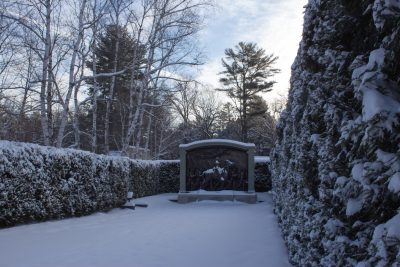
Augustus Saint-Gaudens’s monument to the Massachusetts 54th Regiment led by Colonel Robert Gould Shaw, in snow, surrounded by the park’s signature hedges, Saint-Gaudens National Historic Site. Photo credit: National Park Service.
As the climate changes in northern New England with milder winters and longer summers, we have been watching nervously as certain non-cold-tolerant invasive species continue their northward march. Park staff are particularly nervous about the hemlock wooly adelgid. Saint-Gaudens NHS has two-thirds of a mile of hemlock and white pine hedges that define the park’s landscape. In the mid-Atlantic states, the adelgid has caused massive hemlock die-off. Twenty years ago, there was no adelgid activity reported in New Hampshire, but today the adelgid has been identified in the county where Saint-Gaudens is located. Park staff are starting to consider the appropriate response for continued cultural landscape preservation.
Climate change has many manifestations. Between 1958 and 2012 the incidence of major rainstorm events in New England increased 70 percent, a trend that is expected to continue. Though some of these events, such as Tropical Storm Irene, are wide ranging, others are more localized. In 2013 at Saint-Gaudens NHS a significant microburst thunderstorm dropped 2.5 inches of rain in about an hour, swelling the park’s brooks, destroying the park’s trail system, and severely damaging two historic dams. Increased rain events like these will also impact historic structures. Wooden structures may experience more wood and sill rot, brick structures (particularly historic structures with older mortar) will note greater water infiltration through cracked and deteriorating mortar. Buildings with basements may suffer additional water infiltration into previously dry spaces, leading to mold growth and other new challenges.
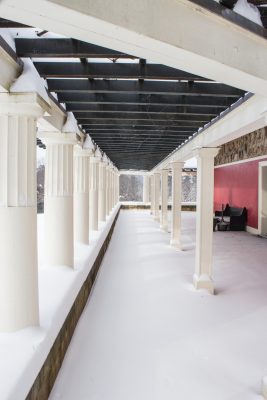
Snow on the brick porch of the Little Studio, Saint-Gaudens National Historic Site. Photo credit: National Park Service.
Historically, in northern New England the first snows fall in November or December. Cold temperatures kept that snow on the ground all winter, with additional snowfalls adding to the snow cover. The new normal, however, seems to be a snow in November or December followed by a period of warming in which the snow melts. The pooled water then freezes again in the evening before melting again during the warmer daytime hours. This freeze-thaw cycle may occur throughout the winter and into the spring. Saint-Gaudens NHS has brick paths, patios, and stairs, many still constructed from historic materials, and these accelerated freeze-thaw cycles seem to be stressing our historic brickwork. Some bricks have popped free of their mortar, creating safety hazards on stairs and paths. Other bricks have cracked and spalled, necessitating their replacement.
In seeking to gain a better understanding of how climate change would impact park resources, we found some keys to making climate change and its impacts relevant to members of the public. Flashy impacts of climate change such as glaciers melting and seas rising are distant reminders of a changing climate for most people. If you don’t live in a flood zone, it is the more immediate impacts, such as those witnessed at Saint-Gaudens, that we will all experience in our homes, in our yards, in our everyday lives that are the most relevant to us.
To get this widely applicable message out, Saint-Gaudens NHS has hosted a variety of public presentations and even sent rangers on the road to speak about climate change impacts in the park. In 2014, the park partnered with the Union of Concerned Scientists on a climate change and cultural resources speaker series. We are also developing a wayside exhibit that identifies some of the changes noted at the park, relating them to impacts visitors may note at their own homes. Our consistent message has been that our climate change impacts are your climate change impacts.
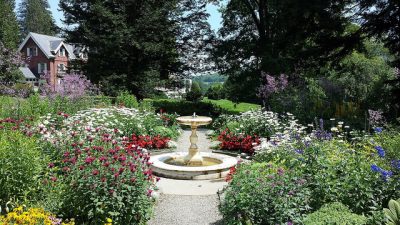
Mansion and formal garden, Marsh-Billings-Rockefeller National Historical Park. Photo credit: National Park Service.
Twenty miles away, Marsh-Billings-Rockefeller National Historical Park in Woodstock, Vermont, has taken a different approach to bridging the relevancy gap, an approach that focuses more on environmental leadership. The park tells the story of the history of conservation in the United States through three families, all with roots on this Vermont property. George Perkins Marsh–lawyer, diplomat, linguist, and polymath–was a keen observer of the Vermont environment. As early as 1847, in remarks to the Agricultural Society of Rutland County, Marsh recognized that human activities were causing changes to the Earth’s climate.
Man cannot at his pleasure command the rain and the sunshine, the wind and frost and snow, yet it is certain that climate itself has in many instances been gradually changed and ameliorated or deteriorated by human action. The draining of swamps and the clearing of forests perceptibly effect the evaporation from the earth, and of course the mean quantity of moisture suspended in the air. The same causes modify the electrical condition of the atmosphere and the power of the surface to reflect, absorb and radiate the rays of the sun, and consequently influence the distribution of light and heat, and the force and direction of the winds.
Marsh’s 1864 book Man and Nature awakened the country’s environmental consciousness. The subsequent occupants of the Marsh property sought to turn Marsh’s theories into practice. Frederick and Julia Billings and their daughters reforested the slopes of Mount Tom within the park and applied scientific forestry techniques to helping the overgrazed and overforested lands recover. Mary and Laurance Rockefeller took the Marsh and Billings legacy of conservation across the nation with their advocacy for national parks and protected lands.
Marsh-Billings-Rockefeller NHP has become a model for sustainable building and energy practices. The park’s landscape is a working forest, the oldest sustainably managed forest in the United States. Each year, timber stands planted by the Billingses and managed by the Rockefellers are thinned and harvested for sustainable yield. That wood returns to the park in a variety of ways.
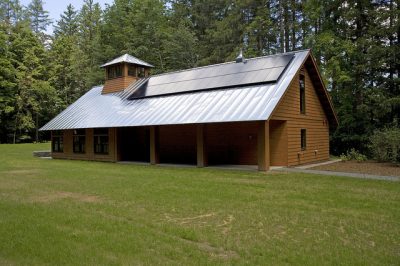
Forest Center, Marsh-Billings-Rockefeller National Historical Park. Photo credit: National Park Service.
In 2008, the park opened its first sustainably built building. Certified at the LEED Platinum level, the Forest Center is made from Forest Stewardship Council-certified wood harvested from the park and is heated with park wood via a wood gasification boiler system. Photovoltaic cells provide power to the building as well as to a historic pony barn that the park rehabilitated in 2012 into a completely off-grid artist studio, also heated with park-harvested wood. The park has replaced numerous oil-fired boilers with wood- and pellet-burning technologies that use the park’s forest as a sustainable fuel source and is in the process of replacing an oil-fired heating system with a geothermal system. With these new systems in place, the park anticipates fossil fuel energy reductions of 80 percent over baselines established in our master energy plan.
These technologies coupled with the conservation message inherent to the park’s story provide ample opportunities for interpretation. Programs focus on the contributions of the park’s key historic figures to conservation history and highlight the park’s role in continuing that conservation leadership. Special programs tie modern technology to the trailblazing work of Marsh, Billings, and Rockefeller. Some systems, as well as stores of cordwood, are purposely easy for visitors to see, in order to drive home the sustainability message that is core to the park’s mission.
Uniquely, the park’s founding was accompanied by the establishment of an institute to help advance conservation practice. If the park is concerned with sharing the history of conservation, the NPS Stewardship Institute is charged with continuing the Rockefeller legacy of promoting conservation practice across the nation. The Institute supports conservation leaders in the NPS, advances practice among conservation professionals, and helps nourish and implement emerging ideas that can benefit conservation practitioners and educators.
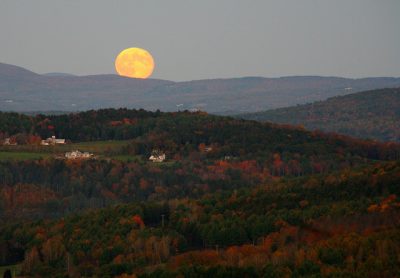
Harvest moon over the hills of Vermont, as seen from Marsh-Billings-Rockefeller National Historical Park. Photo credit: National Park Service.
Two different national parks and two different approaches to using cultural resources to bridge the relevancy gap. Saint-Gaudens has focused its efforts on identifying the likely impacts of climate change on historic resources as a means of raising awareness and building a future constituency. Marsh-Billings-Rockefeller has used its historical legacy of action to become a model for sustainable technologies. As parks with strong cultural and historical slants, talking about complex natural resource topics such as human-caused climate change can be a challenge. But as the National Park Service continues to develop its abilities in this area, both parks will be well-situated to even more effectively link history to climate change to bridge the relevancy gap.
~ Rick Kendall, an archaeologist by training, is superintendent of Saint-Gaudens National Historic Site in New Hampshire, Marsh-Billings-Rockefeller National Historical Park, and the NPS Stewardship Institute in Vermont.




Hi! This may be a little off-the-track but colleagues and I just wrote an article on Asian Women and Climate Change Adaptation in India, Indonesia, Thailand, and Vietnam. Let me know if you are interested in this at all. Happy to share!